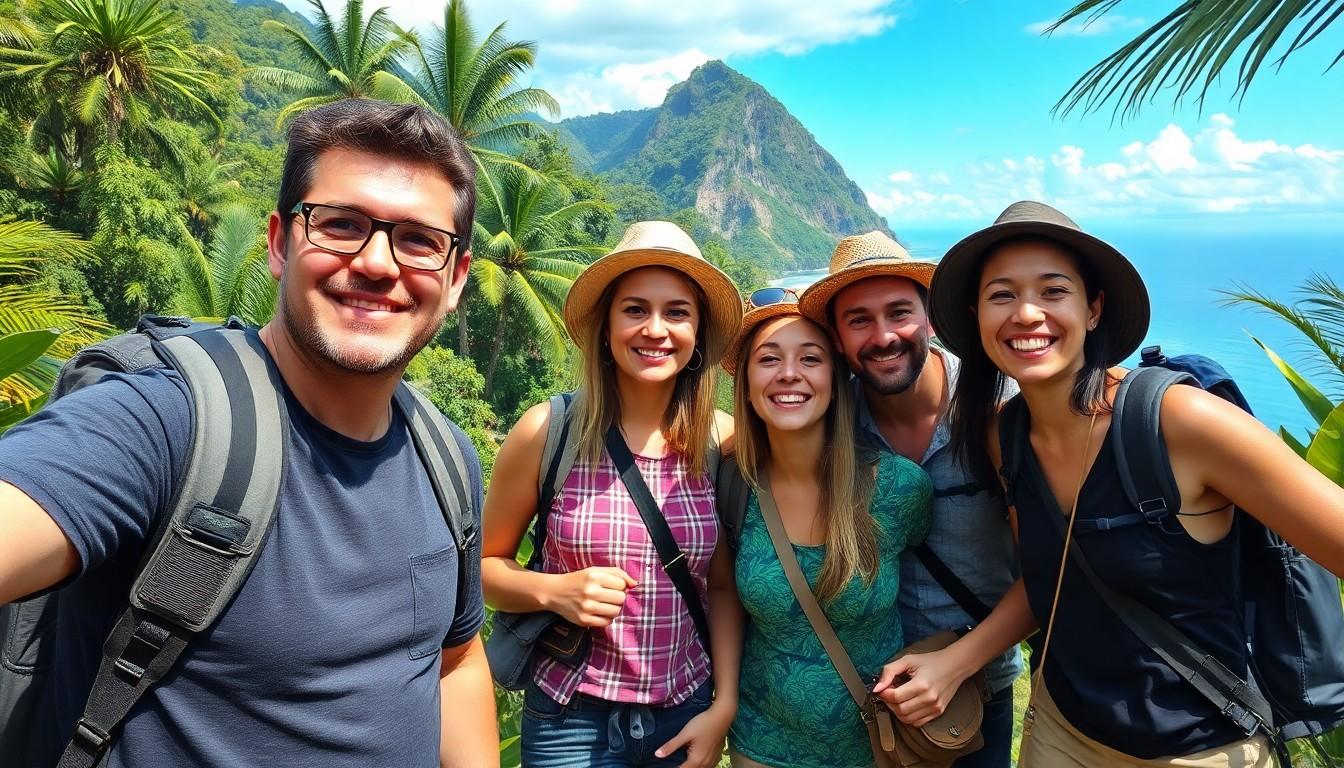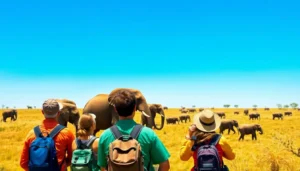Table of Contents
ToggleAdventure travel has a way of calling to the wanderlust in all of us. But as the world opens up, many are left wondering if this thrilling pursuit is still worth the investment. Is overseas adventure travel solvent, or is it just a fancy way to put your money on a one-way ticket to disappointment?
With the right planning and a sprinkle of spontaneity, adventure travel can be both exhilarating and financially viable. Picture yourself trekking through lush rainforests, sipping coffee on a mountain peak, and dodging the occasional llama. It’s not just about the Instagram posts; it’s about creating memories that last a lifetime. So, let’s dive into whether this globetrotting escapade is a wise choice or if it’s time to stick to the local coffee shop for your next adventure.
Overview of Adventure Travel
Adventure travel encompasses a range of activities designed to provide excitement and new experiences. Travelers seek exploration beyond traditional vacations, often engaging in activities like trekking, rock climbing, or diving. These experiences allow adventurers to connect with nature, confront challenges, and immerse themselves in diverse cultures.
Various forms of adventure travel exist, including ecotourism for nature enthusiasts and cultural journeys for those wanting to learn from local communities. Many travelers prioritize experiences that foster personal growth and offer unique storytelling opportunities. Engaging with local traditions often enhances the adventure, adding depth to the journey.
Statistics indicate a significant rise in adventure tourism’s popularity. According to the Adventure Travel Trade Association, the industry reached a market size of $683 billion in 2021, demonstrating robust growth. Many believe that adventure travel not only contributes to personal enrichment but also supports local economies through tourism.
Destinations worldwide cater to adventure seekers. Countries like New Zealand attract thrill-seekers with bungee jumping and skydiving, while Costa Rica offers zip-lining and surfing. These options provide travelers with multiple choices tailored to their interests and risk levels.
Safety remains a crucial consideration in adventure travel. Reputable tour operators assess risks and provide guidance to ensure a secure experience. Travelers often emphasize the importance of choosing organized tours with certified guides for maximum safety.
Adventure travel proves an appealing choice for those seeking excitement and meaningful experiences. It encourages individuals to step outside their comfort zones and engage with the world differently. As the landscape of travel continues to evolve, adventure tourism thrives, inviting individuals to discover their next extraordinary experience.
Financial Aspects of Overseas Adventure Travel

Overseas adventure travel involves various financial considerations that impact many travelers. Costs associated with these journeys can fluctuate widely based on several factors.
Costs Involved
Travelers encounter costs related to transportation, accommodations, and activities. For instance, airfare may range from $300 to over $1,500 depending on the destination. Individual daily expenses add up quickly, spanning meals, tours, and gear rentals. Participants opting for guided tours often face package prices ranging from $1,000 to $5,000 depending on the itinerary. Insurance is another expense, typically costing around 4% to 10% of the total trip cost, providing essential coverage against unforeseen circumstances.
Revenue Sources
Adventure travel generates revenue through multiple channels. Tour operators play a pivotal role, offering packages and experiences that cater to various budgets. Local economies benefit significantly as travelers spend money on activities, lodging, and food, creating jobs and fostering growth. Statistics indicate adventure tourism contributes $683 billion to the global tourism market. Additionally, online platforms facilitate bookings and provide exposure for smaller operators. Increasing demand for unique experiences has led to an uptick in industry players, expanding potential revenue streams and opportunities.
Market Trends in Adventure Travel
Adventure travel has seen significant growth in recent years, reflecting a rising interest in unique experiences. The industry reached a market size of $683 billion in 2021, with projections indicating further expansion. This growth is driven by demand for personalized itineraries and immersive experiences that connect travelers with local cultures. Adventure tourism encompasses a wide range of activities, catering to diverse interests, which encourages participation among various demographics.
Growth Patterns
Increased participation in adventure travel stems from changing consumer preferences. Preferences reflect a shift toward experiential travel, where travelers prioritize activities that offer authentic interactions. Reports indicate a compound annual growth rate of 15% in adventure tourism from 2020 to 2027. Tour operators adapt offerings to meet this demand, introducing innovative packages and tailored experiences. New destinations continually emerge, each boasting unique adventures that captivate potential travelers.
Customer Demographics
The demographics of adventure travelers reveal a diverse audience. Millennials represent a significant portion, with 72% indicating a preference for experiential travel. Baby boomers also increasingly invest in adventure trips, chasing new adventures during retirement. Gender distribution shows an almost equal interest, with men and women participating in various adventure activities. Those aged 25 to 40 tend to spend more on adventure experiences, valuing personal growth and memorable storytelling.
Challenges Facing the Industry
Multiple challenges hinder the success of overseas adventure travel, impacting its financial stability and long-term growth.
Economic Factors
Economic fluctuations influence travelers’ disposable income, affecting their willingness to invest in adventure trips. Rising inflation has made it difficult for many individuals to allocate funds for non-essential activities like travel. Tour operators also experience pressure, as increasing operational costs, such as fuel and wages, lead to higher package prices. Reports indicate that guided tours can vary significantly, ranging from $1,000 to $5,000, depending on destination and services offered. Moreover, travelers prioritize value for money, making it essential for operators to provide unique experiences tailored to individual preferences to remain competitive.
Environmental Concerns
Environmental sustainability becomes a key factor in the future of adventure travel. Tourists grow increasingly aware of their ecological impact, and many seek out eco-friendly options. Destinations that prioritize conservation efforts often attract environmentally conscious travelers. Implementation of responsible travel practices plays a significant role in shaping the industry’s reputation. Data show that 66% of adventure travelers consider sustainability when making choices. Therefore, operators who adapt their practices to prioritize ecological health can strengthen their appeal and attract a wider audience.
Future Outlook on Adventure Travel
Growth in adventure travel shows promising potential. The market anticipates a compound annual growth rate of 15% from 2020 to 2027. Increasing interest in personalized itineraries fuels this expansion, drawing diverse demographics like millennials and baby boomers into the adventure tourism fold.
Emerging destinations continue to captivate adventurers, pushing traditional travel boundaries. Countries such as New Zealand and Costa Rica remain popular, but lesser-known locations gain attention, offering fresh thrills. Travelers seek out unique experiences that foster personal enrichment, prompting operators to innovate and diversify their offerings.
Economic factors play a role in shaping the industry’s landscape. Rising operational costs and travelers’ disposable income influence pricing strategies. Tour operators face challenges in balancing affordability with quality services, as guided tours average between $1,000 and $5,000.
Sustainability remains a significant consideration. A majority of travelers—66%—value ecological impact in their decision-making. Responsible travel practices not only appeal to the growing environmentally conscious audience but also drive the shift toward more sustainable tourism models.
Competition among adventure travel providers strengthens as new players enter the field. Increased revenue streams create opportunities for local economies and establish jobs. Engaging with local communities enhances the overall traveler experience while contributing to economic growth.
Adventure travel’s future hinges on adaptability and innovation. Meeting the evolving preferences of travelers is crucial. The industry must embrace emerging trends, including sustainable practices and personalized experiences, to remain competitive and relevant. As travelers continue to seek adventure worldwide, those that prioritize these factors will likely thrive.
Overseas adventure travel stands at a crossroads of excitement and financial viability. As demand for unique experiences grows travelers are increasingly willing to invest in unforgettable journeys. The balance between cost and quality is crucial as operators adapt to changing preferences while prioritizing sustainability.
With emerging destinations and innovative itineraries the industry is poised for continued growth. Travelers who embrace adventure not only enrich their lives but also contribute to local economies. This dynamic sector is set to thrive as it meets the evolving desires of a diverse audience seeking transformation through exploration.




